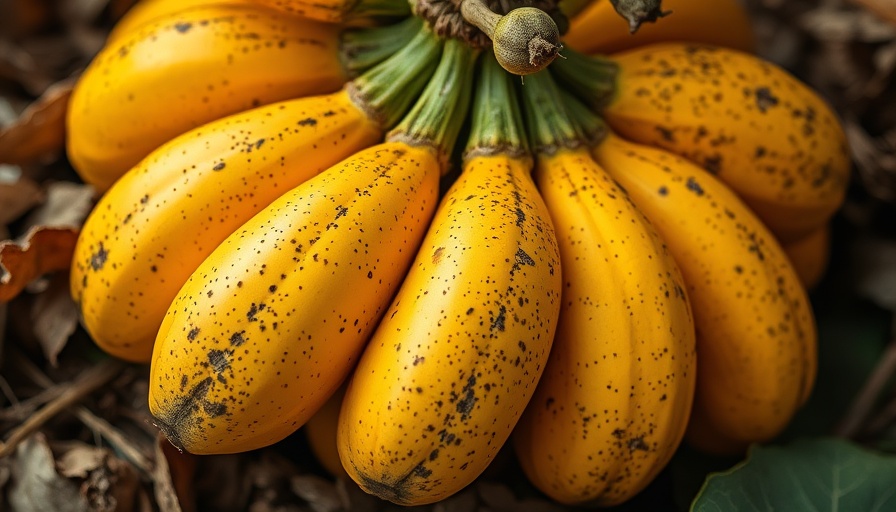
Why You Should Embrace Banana Squash in Your Garden
As gardening enthusiasts, it’s tempting to stick with the usual zucchini and tomatoes, but introducing banana squash into your vegetable garden can be a delightful surprise. With its unique shape and vibrant colors, banana squash not only adds visual interest but also offers an abundant harvest. Imagine a single plant yielding enough sweet flesh to fill your freezer, allowing you to create delicious dishes all winter long.
Unpacking the Delight of Banana Squash
Banana squash, scientifically known as Cucurbita maxima, is an annual vining vegetable that hails from South America. The fruits can grow to impressive sizes, often weighing over 60 pounds and reaching lengths of 24 inches. More than just a quirky choice, banana squash has seasoned chefs and home cooks raving about its delightful flavor profile.
The squash boasts a smooth, creamy texture comparable to butternut squash, making it perfect for soups, roasting, or even baking into pies. Its vibrant orange flesh provides a nutritious boost to any meal, rich in vitamins and minerals, aligning perfectly with the growing trend of health-conscious cooking.
Planting Tips for a Successful Harvest
For those eager to take on the challenge of growing banana squash, several key factors play a role in ensuring a successful garden. First, it thrives in well-draining, loamy soil rich in organic material — think compost and mulch. When planting, space the seeds 3 to 6 feet apart in full sun to allow adequate space for the sprawling vines.
Soil pH should be kept between 5.8 and 6.8 for optimal plant growth, so don’t hesitate to test your soil and make adjustments as necessary. Seeds should be planted around 1 inch deep, and with a bit of patience, you'll see sprouts emerge in no time. Typically, banana squash requires about 90 to 120 days to reach maturity, so keep an eye on your watering, especially during dry spells.
Addressing Common Challenges
Like any gardener will attest, pests and diseases can pose significant challenges. Common contenders include squash borers and aphids, which can impact your yield. Implementing a companion planting strategy can help significantly; for example, planting marigolds nearby can deter pests while attracting beneficial insects.
Additionally, ensure proper spacing and watering techniques to foster healthy growth. Overcrowding can lead to poor air circulation, increasing the likelihood of fungal issues. Instead, embrace a proactive approach by monitoring your plants regularly for any signs of distress.
Harvesting and Storage: Maximizing Your Bounty
Once the squash has matured, harvesting should be timed carefully. You’ll know they’re ready when the skin feels tough, and they exhibit a beautiful color contrast — deep blue or pink on the exterior with rich orange flesh peeking through the stem. Use a sharp knife to cut the squash away from the vine, leaving a few inches of stem attached.
To store your bounty, keep them in a cool, dry place, ideally around 50°F to 60°F. With proper care, banana squash can last for several months, allowing you to enjoy your harvest well into the colder seasons.
Creative Cooking Ideas: From Soups to Sweets
Why stop at just roasting? The versatility of banana squash allows for an array of delicious culinary possibilities. They can be pureed into creamy soups, roasted with herbs and olive oil, or even sliced thin for layering in a pie or casserole. Don’t forget to explore traditional recipes from various cultures that embrace this delightful squash.
For those with a sweet tooth, banana squash can be used in desserts as well! Think banana squash muffins or pies — a unique twist that might just become your new family favorite.
Conclusion: Start Your Banana Squash Journey Today!
Incorporating banana squash into your garden not only expands your gardening repertoire but also opens a world of culinary opportunities. It’s time to elevate your vegetable gardening experience and embrace the joy of growing and cooking with one of nature’s delicious gifts. Why wait? Roll up your sleeves, gather your seeds, and confidently embark on your banana squash adventure!
 Add Row
Add Row  Add
Add 




Write A Comment